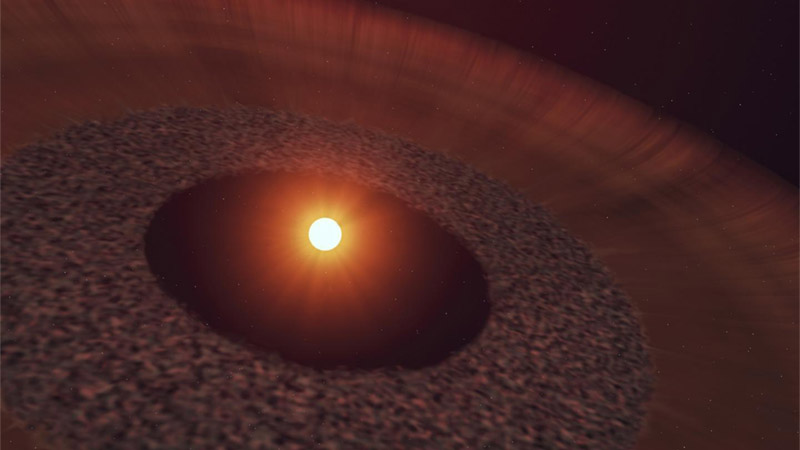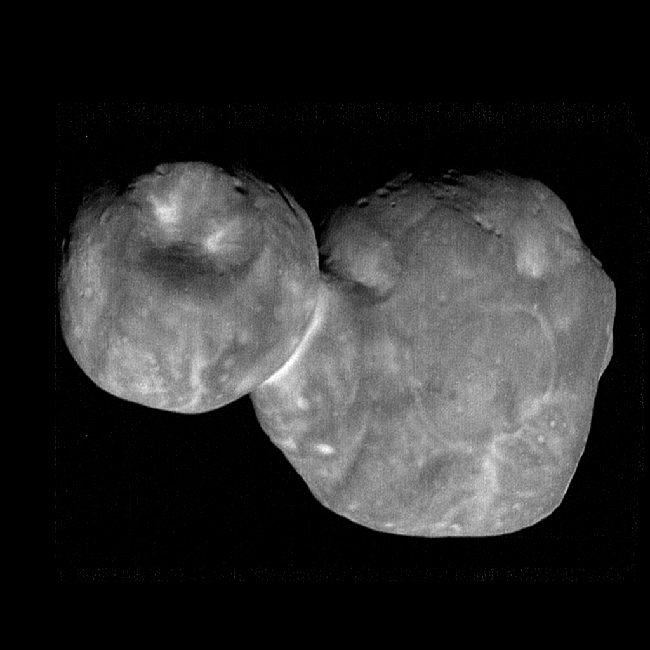

Artist’s concept of NO Lupi, a hot young class III star located 400 light-years away from Earth in the Lupus Star Forming Region. NO Lupi was observed to have a disk of dust and gas, making it a likely candidate for comet and asteroid formation. The star is also providing a unique look into planetary system formation as the gas surrounding it is flowing rapidly away from the star at a rate of 22 kilometers per second (2,237 mph). Image via Institute of Astronomy, University of Cambridge.
A team of astronomers, led by scientists from the University of Cambridge in the U.K., said on November 30, 2020, that they’ve discovered carbon monoxide gas flowing at an unprecedented rate from a young star system some 400 light-years from Earth. They said the discovery represents a unique stage in the evolution of planets, not previously seen in young, low-mass stars.
The finding might help astronomers understand how solar systems form.
The scientists originally surveyed 30 young stars at similar stages of evolution in dense, dark star-forming clouds – located in the direction of the southern constellation Lupus the Wolf – and hence called the Lupus Star Forming Region. The scientists were working, originally, to understand how and when asteroids and comets form in planetary systems. Scientists often observe stars in the Lupus clouds because stars are actively forming there. Protostars and other very young stars, and their systems, can be observed there in various stages of development. One star in particular – known to astronomers as NO Lupi, or NO Lup for short – showed promising signs of comet and asteroid formation. But it also displayed an oddity: gas flowing away from the star.
Generally speaking, gas is sometimes seen to flow from young stars. But not at the stage where comets and asteroids have already formed. Thus this phenomenon – gas flowing from a star mature enough to have comets and asteroids – gives astronomers a glimpse of a planet-forming process they didn’t expect.
These scientists’ paper is published in the peer-reviewed journal Monthly Notices of the Royal Astronomical Society.
NO Lup is an ordinary star, in an earlier stage of evolution than our sun. It contains roughly 70% the mass of our sun. According to a statement, scientists quickly found that NO Lup had a faint, low-mass dusty disk. Of the 30 stars in this study, it was the only star where scientists detected the outflow of carbon monoxide gas. This fact might cause them to wonder, for example, if this gas outflow is a very brief stage in planet formation.
This detection was a first for the ALMA telescope in Chile. With only a 30-minute observation of NO Lup for reference, scientists were surprised at the detection.

Joshua Lovell, a Ph.D. student at the University of Cambridge’s Institute of Astronomy in the U.K., is the lead author on the study. Image via Institute of Astronomy.
Joshua Lovell, a Ph.D. student at the University of Cambridge’s Institute of Astronomy and lead author on the research, told EarthSky:
In our survey we looked at 29 other stars at a similar age and stage of evolution as NO Lup. However, only this one star was observed with gas. Given their young age, this meant that the event that we witnessed must be rare. None of this would have been possible without instruments as sensitive as ALMA, nor the previous research into young stars and their discs on which our study was based.
The presence of the carbon monoxide gas wasn’t the only unique and rare thing about NO Lup. Further inspection revealed that the gas was flowing out from the star at the unprecedented rate of 22 kilometers per second (2,237 mph), a figure determined through the modeling work of Grant Kennedy, Royal Society University Fellow at the University of Warwick. Kennedy said in a statement:
We found a simple way to explain it: by modelling a gas ring, but giving the gas an extra kick outward. Other models have been used to explain young discs with similar mechanisms, but this disc is more like a debris disc where we haven’t witnessed winds before. Our model showed the gas is entirely consistent with a scenario in which it’s being launched out of the system at around 22 kilometres per second, which is much higher than any stable orbital speed.
Lovell clarified that the closer an object or gas is to its star, the faster it is expected to orbit, but that the distance of the gas from NO Lup meant it couldn’t be in a stable orbit around the star, and instead had to be flowing out of the system. He said:
The gas … was being ejected from the system at high speeds. This makes NO Lup unique: stars where we expect comets and asteroids to have formed have not been observed before with outflowing gas. This suggests that the gas could be produced during a short period in which the surfaces of the comets are being ‘vaporized,’ producing large volumes of carbon monoxide. Although, we cannot yet fully explain how the gas is being ejected.

In 2019, NASA’s New Horizons mission arrived at 486958 Arrokoth – formerly nicknamed Ultima Thule – for a flyby. While imaging the Kuiper Belt object, scientists discovered evidence of sublimation – the transition of an object from solid to gas – that had occurred 4.5 billion years earlier. Image via NASA/ Johns Hopkins Applied Physics Laboratory/ SwRI/ National Optical Astronomy Observatory.
The production of carbon monoxide through comet vaporization – when a liquid becomes a gas – or sublimation – when a solid becomes a gas without becoming a liquid first – and by asteroid collisions, isn’t unique to NO Lup. In fact, evidence suggests these same processes may have occurred very early in the formation of our own solar system.
In 2019, NASA’s New Horizons mission discovered evidence of 4.5 billion-year-old sublimation evolution on the surface of 486958 Arrokoth – previously nicknamed Ultima Thule before receiving its official moniker – in the Kuiper Belt.
The detection of these same processes in action in the NO Lup system could have implications for scientists’ understanding of the evolution of comets, asteroids, and planets, including those in our own solar system, since scientists are watching them happen, rather than finding them billions of years later.
Bottom line: An unexpected flow of fast-moving carbon monoxide gas outward from a young star – which already has asteroids and comets – may provide insight into how planets form.
Source: Rapid CO gas dispersal from NO Lup’s class III circumstellar disc
from EarthSky https://ift.tt/33LSRLi


Artist’s concept of NO Lupi, a hot young class III star located 400 light-years away from Earth in the Lupus Star Forming Region. NO Lupi was observed to have a disk of dust and gas, making it a likely candidate for comet and asteroid formation. The star is also providing a unique look into planetary system formation as the gas surrounding it is flowing rapidly away from the star at a rate of 22 kilometers per second (2,237 mph). Image via Institute of Astronomy, University of Cambridge.
A team of astronomers, led by scientists from the University of Cambridge in the U.K., said on November 30, 2020, that they’ve discovered carbon monoxide gas flowing at an unprecedented rate from a young star system some 400 light-years from Earth. They said the discovery represents a unique stage in the evolution of planets, not previously seen in young, low-mass stars.
The finding might help astronomers understand how solar systems form.
The scientists originally surveyed 30 young stars at similar stages of evolution in dense, dark star-forming clouds – located in the direction of the southern constellation Lupus the Wolf – and hence called the Lupus Star Forming Region. The scientists were working, originally, to understand how and when asteroids and comets form in planetary systems. Scientists often observe stars in the Lupus clouds because stars are actively forming there. Protostars and other very young stars, and their systems, can be observed there in various stages of development. One star in particular – known to astronomers as NO Lupi, or NO Lup for short – showed promising signs of comet and asteroid formation. But it also displayed an oddity: gas flowing away from the star.
Generally speaking, gas is sometimes seen to flow from young stars. But not at the stage where comets and asteroids have already formed. Thus this phenomenon – gas flowing from a star mature enough to have comets and asteroids – gives astronomers a glimpse of a planet-forming process they didn’t expect.
These scientists’ paper is published in the peer-reviewed journal Monthly Notices of the Royal Astronomical Society.
NO Lup is an ordinary star, in an earlier stage of evolution than our sun. It contains roughly 70% the mass of our sun. According to a statement, scientists quickly found that NO Lup had a faint, low-mass dusty disk. Of the 30 stars in this study, it was the only star where scientists detected the outflow of carbon monoxide gas. This fact might cause them to wonder, for example, if this gas outflow is a very brief stage in planet formation.
This detection was a first for the ALMA telescope in Chile. With only a 30-minute observation of NO Lup for reference, scientists were surprised at the detection.

Joshua Lovell, a Ph.D. student at the University of Cambridge’s Institute of Astronomy in the U.K., is the lead author on the study. Image via Institute of Astronomy.
Joshua Lovell, a Ph.D. student at the University of Cambridge’s Institute of Astronomy and lead author on the research, told EarthSky:
In our survey we looked at 29 other stars at a similar age and stage of evolution as NO Lup. However, only this one star was observed with gas. Given their young age, this meant that the event that we witnessed must be rare. None of this would have been possible without instruments as sensitive as ALMA, nor the previous research into young stars and their discs on which our study was based.
The presence of the carbon monoxide gas wasn’t the only unique and rare thing about NO Lup. Further inspection revealed that the gas was flowing out from the star at the unprecedented rate of 22 kilometers per second (2,237 mph), a figure determined through the modeling work of Grant Kennedy, Royal Society University Fellow at the University of Warwick. Kennedy said in a statement:
We found a simple way to explain it: by modelling a gas ring, but giving the gas an extra kick outward. Other models have been used to explain young discs with similar mechanisms, but this disc is more like a debris disc where we haven’t witnessed winds before. Our model showed the gas is entirely consistent with a scenario in which it’s being launched out of the system at around 22 kilometres per second, which is much higher than any stable orbital speed.
Lovell clarified that the closer an object or gas is to its star, the faster it is expected to orbit, but that the distance of the gas from NO Lup meant it couldn’t be in a stable orbit around the star, and instead had to be flowing out of the system. He said:
The gas … was being ejected from the system at high speeds. This makes NO Lup unique: stars where we expect comets and asteroids to have formed have not been observed before with outflowing gas. This suggests that the gas could be produced during a short period in which the surfaces of the comets are being ‘vaporized,’ producing large volumes of carbon monoxide. Although, we cannot yet fully explain how the gas is being ejected.

In 2019, NASA’s New Horizons mission arrived at 486958 Arrokoth – formerly nicknamed Ultima Thule – for a flyby. While imaging the Kuiper Belt object, scientists discovered evidence of sublimation – the transition of an object from solid to gas – that had occurred 4.5 billion years earlier. Image via NASA/ Johns Hopkins Applied Physics Laboratory/ SwRI/ National Optical Astronomy Observatory.
The production of carbon monoxide through comet vaporization – when a liquid becomes a gas – or sublimation – when a solid becomes a gas without becoming a liquid first – and by asteroid collisions, isn’t unique to NO Lup. In fact, evidence suggests these same processes may have occurred very early in the formation of our own solar system.
In 2019, NASA’s New Horizons mission discovered evidence of 4.5 billion-year-old sublimation evolution on the surface of 486958 Arrokoth – previously nicknamed Ultima Thule before receiving its official moniker – in the Kuiper Belt.
The detection of these same processes in action in the NO Lup system could have implications for scientists’ understanding of the evolution of comets, asteroids, and planets, including those in our own solar system, since scientists are watching them happen, rather than finding them billions of years later.
Bottom line: An unexpected flow of fast-moving carbon monoxide gas outward from a young star – which already has asteroids and comets – may provide insight into how planets form.
Source: Rapid CO gas dispersal from NO Lup’s class III circumstellar disc
from EarthSky https://ift.tt/33LSRLi

Aucun commentaire:
Enregistrer un commentaire